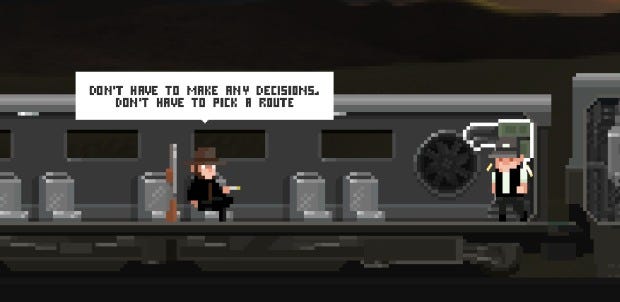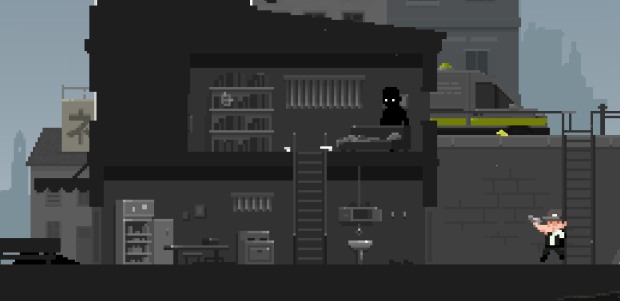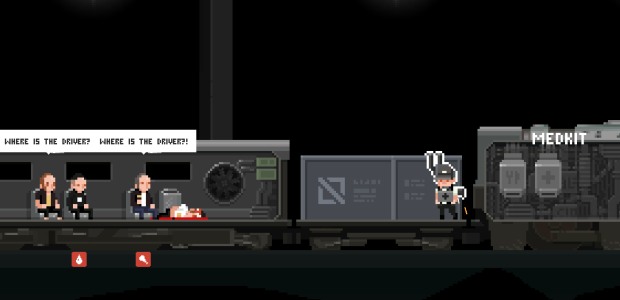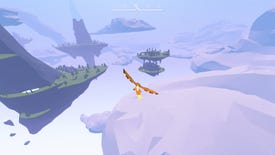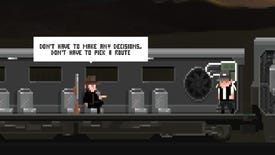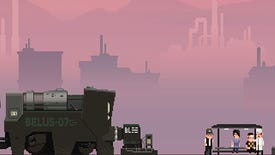Wot I Think: The Final Station
A low-budget scifi horror flick.
I hate ladders, ladders are my enemy. The world is coming to an end; I am driving a temperamental train to one forsaken town after another; I am rescuing survivors and then mopping up their remains when they expire in my carriage; and I am hunting for the tools to advance amid derelict buildings full of zombie-like silhouette monsters. But it's the ladders in The Final Station that provide the largest obstacle.
The Final Station is an austere, side-scrolling action game. The world is experiencing a "second visitation", of what it's not clear, but the result is a lot of people being killed, often by their panicked fellow humans, and a new population of violent silhouettes with beady white eyes. As a train driver, you're given an order to travel south with some important cargo, and at each stop you're forced to disembark and search for an access code that lets you continue on your journey.
That splits the game into two halves: train sections, and on foot sections. The train parts are simple enough. During each journey, one part of your train will be malfunctioning and require you to pull a level/hammer a button/time your button presses in order to maintain it. Meanwhile the passengers in your carriage, who you rescue in your on foot sections, will require feeding and healing while they fill in the story by bantering among themselves. It feels like busywork and quickly becomes rote, but you're given money as a reward if you can get the survivors to their destination settlement in one piece. That money, in turn, can be used at vendors in those settlements to buy ammo, health packs and more food.
The other half, and the core of the game, is spent on foot. Each hand-designed level works the same way: you arrive at the station to find that the person who has the code to unlock the barrier blocking your train has wandered off somewhere else. You must adventure further in search of them, or what remains of them, and thus deal with the monsters you find along the way.
Those inky enemies come in different varieties; they're unnamed, so I'll give them my own. There's the Shamblers, who trundle slowly towards you and swipe when they get near; the Rushers, who run at you quickly and lunge and bite when within range; the Tallboys, who are like Shamblers but taller and more powerful; the Armored Shamblers, who must be melee'd once to remove their helmet and then shot in the head to finish; the Exploders, who are on fire and blow up when close or when shot; and the Humpers, who run at you like the Rushers do and latch on to you in order to do damage.
Like much zombie fiction, in isolation no single enemy poses much threat to you. The inconvenience is that you'll rarely encounter them on their own, that ammo is at times scarce, and that you can never see what's in a room ahead until you open the door. If it's a couple of Shamblers, then great; you can edge backwards while punching them in order to conserve ammo and never get hit. If it's an Exploder on his own, then that's still fine; shoot him at range and he'll explode harmlessly. If it's an Armored Shambler with an Exploder behind him, then that's where things get trickier. Shooting the Exploder will cause him to blow up and take the Armored Shambler with him, but the Armored Shambler is in front and will deflect the bullets. You need to get close, punch him to knock off his helmet, then shoot him to kill him, and then deal with the Exploder who by now has probably already got close enough and detonated.
You have three weapons with which to deal with the problem: a pistol, a shotgun and a rifle. You'll spend most of the game using the pistol, as you don't get the rifle till near the end and because shotgun ammo is more scarce. You can also pick up various items in the environment, such as crates, office chairs and for some reason toilets, to throw them at enemies for a one-hit kill, though whether you can do so quickly enough while being rushed by enemies is another question.
Yet the largest challenge I faced were ladders: it takes a few moments to get on and off them and enemies can strike you in the head before your weapon has a clear shot to allow you to fight back. More often than not you're going to spend your time either thoughtlessly firing bullets into crowds in order to thin their number or backwalking and punching.
This is a problem. The Final Station feels like a game that should be about the tension between exploring more in pursuit of resources and survivors, and avoiding further risk in favour of boarding the train again as quickly as possible. Instead enemies often feel like little more than an inconvenience, rather than an outright threat. You'll learn simple tricks to dealing with them and by about two-thirds through the game I had gathered enough crafting materials to make everything I needed in abundance on the train between missions. Even when I did die, I was only ever set back to a checkpoint with little or no progress lost.
In many games that generous checkpoint system would be a boon, but here, without even a cost in terms of resources, it removes any sense of fear from the world. You can afford to be rash and, with the threat depleted, that leaves the on foot sections often feeling rote by the end of the game, too.
Yet it's not a damning issue. Though I was ready for it to end when it did, I enjoyed myself for the game's 4-5 hour running time. There is a satisfying sense of exploration as you move through levels, revealing each room, rescuing survivors, and gradually finding your way through each of its locked doors. That's helped by the level design, which neatly loops back on itself each time to stop you ever needing to backtrack towards your train, and through which much of the story of the world is told. You'll discover notes on tables and walls that you can read, revealing details about what went on in the buildings before you arrived, and the buildings themselves vary from blocks of apartments, to mountaintop mansions home to some dread machinery, underground research facilities with grisly experiments happening inside, and new cities built into cliff faces.
The story these locations and notes tell runs the sci-fi, fantasy and supernatural gamut, hinting at but never outright stating a backstory involving aliens, viruses, giant robots, tentacled beasts and more. You glean details in part through conversations with NPCs you meet at settlements, which are short and never particularly witty, but which are more engaging by the fact that your character seems to speak but you never see your own dialogue, thus forcing you to piece the context of people's responses together in your own mind. Oddly you're also able to have conversations via a communication link on the train, this time with occasional choices about what to say, and there you do see your responses.
The Final Station is a simple game, which is always just compelling enough for its duration. I've come to think of it as an efficient, low budget horror movie: it has a high concept it can't afford to show directly and so it wrings as much as it can from the mystery and the satisfaction of piecing the plot together from snippets. It's only a shame that its action suffers more from never having a particularly interesting concept of its own.
The Final Station is out tomorrow on Windows and Mac via Steam and Humble for £11/$15/€15, with a 20% discount at the time of writing.
